MIBS, AIS edition
When we got excited about the Standard Horizon GX2100 AISrx/VHF (now well documented at SH), did anyone realize that the already versatile CMP30 RAM3 remote station would also show the targets? Well, there it was in Miami, looking pretty much like the photo above. And GX2100 love hasn’t waned; the set was one of West Marine’s show highlights and it won the NMMA Innovation Award in the Electronics category. Of course there was plenty more going on in the AIS department…
Indeed, Icom had the much anticipated MR-500TR Class B AIS transponder prominently displayed in front of its booth. Unfortunately it was in a glass case, so yours truly couldn’t push buttons, and, since it’s not quite FCC approved yet, Icom USA can’t yet reveal a price. But it’s looking good, as is its rather hunky GPS antenna, in my opinion. An Icom representative said that people seemed to either love it or hate the big mushroom, and that the latter can use another antenna.
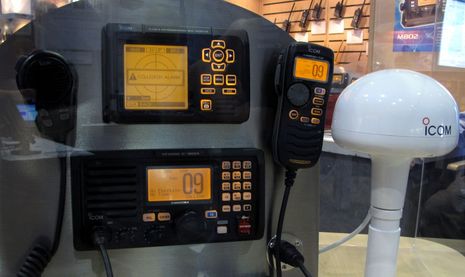 Also awaiting approvals is ComNav’s Voyager X3 Class A AIS (with NMEA 2000). But I was able to work through its menus, like the voyage data screen seen below, and I’m even more excited about this second generation transponder. Plus there’s the news that other companies may sell essentially this same unit for well below $3,000 and it is even slated for IMO approval. That’s big news for bigger yachts (and big competition for the likes of Furuno); it may also mean that the USCG will be more likely to specify Class A when it finally mandates AIS on lots more U.S. commercial vessels.
Also awaiting approvals is ComNav’s Voyager X3 Class A AIS (with NMEA 2000). But I was able to work through its menus, like the voyage data screen seen below, and I’m even more excited about this second generation transponder. Plus there’s the news that other companies may sell essentially this same unit for well below $3,000 and it is even slated for IMO approval. That’s big news for bigger yachts (and big competition for the likes of Furuno); it may also mean that the USCG will be more likely to specify Class A when it finally mandates AIS on lots more U.S. commercial vessels.
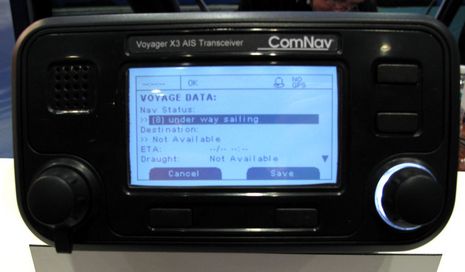 It seemed fairly easy to input Class A voyage data (like destination, ETA, etc.) on the X3 transponder, but might be even easier on Digital Yacht’s new SmarterTrack PC software, whose ‘Lite’ version is designed to be a full transponder interface as well as an AIS plotting program that will ship free with DY’s various AIS products. The screen below, though, shows the full $400 navigation version which supports Navionics chart cards of all formats. Click on the screen and check out the immense control a user gets over how targets are displayed. Note too that the program saves static data on every MMSI it sees, so the vessel name, etc. pop up instantly instead of having to wait minutes for the static data transmission. But don’t be fooled by that “Show Class B” check mark on the top bar; you can’t make them all disappear, just the ones that are not “threats” as defined by your CPA/TCPA settings. It all looks smart, and close to how the IMO envisions efficient AIS plotting, and I look forward to trying the program. (DY was also showing a beta version of its little C-Map plotter/AISrx, and still has lots more interesting product ideas left.)
It seemed fairly easy to input Class A voyage data (like destination, ETA, etc.) on the X3 transponder, but might be even easier on Digital Yacht’s new SmarterTrack PC software, whose ‘Lite’ version is designed to be a full transponder interface as well as an AIS plotting program that will ship free with DY’s various AIS products. The screen below, though, shows the full $400 navigation version which supports Navionics chart cards of all formats. Click on the screen and check out the immense control a user gets over how targets are displayed. Note too that the program saves static data on every MMSI it sees, so the vessel name, etc. pop up instantly instead of having to wait minutes for the static data transmission. But don’t be fooled by that “Show Class B” check mark on the top bar; you can’t make them all disappear, just the ones that are not “threats” as defined by your CPA/TCPA settings. It all looks smart, and close to how the IMO envisions efficient AIS plotting, and I look forward to trying the program. (DY was also showing a beta version of its little C-Map plotter/AISrx, and still has lots more interesting product ideas left.)
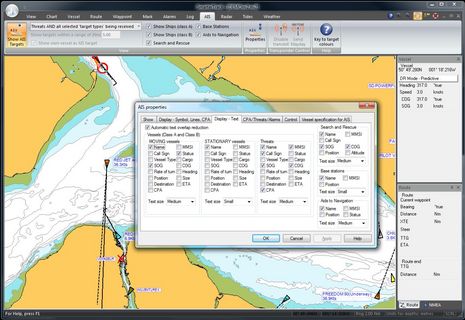 One thing I’ll look for in SmarterTrack, and other AIS plotters, will be an alarm system as complete as what’s in the Vesper Marine aisWatchMate. I finally got to see one in the flesh and it did not disappoint. For instance, I hadn’t considered the value an alarm filter based on your own boat’s speed before discussing it with U.S. distributor Steven Gloor (whose card also lends scale to the photo). If you’re, say, a fisherman who often slows way down and dawdles around this way and that, you might well avoid unneeded CPA alarms by applying such a filter. Which you can have assigned to one or more profiles designed for different boating situations. Vesper’s manuals remain succinct, but I hope MFD and charting software developers check them out, maybe even purchase a unit, to appreciate what full-bodied, effective AIS alarming entails. If your product alarms a lot when users don’t want it to, like when driving into a harbor full of moored ships (see Target Speed filter below), then your users will be tempted to minimize alarms altogether, and may resent you.
One thing I’ll look for in SmarterTrack, and other AIS plotters, will be an alarm system as complete as what’s in the Vesper Marine aisWatchMate. I finally got to see one in the flesh and it did not disappoint. For instance, I hadn’t considered the value an alarm filter based on your own boat’s speed before discussing it with U.S. distributor Steven Gloor (whose card also lends scale to the photo). If you’re, say, a fisherman who often slows way down and dawdles around this way and that, you might well avoid unneeded CPA alarms by applying such a filter. Which you can have assigned to one or more profiles designed for different boating situations. Vesper’s manuals remain succinct, but I hope MFD and charting software developers check them out, maybe even purchase a unit, to appreciate what full-bodied, effective AIS alarming entails. If your product alarms a lot when users don’t want it to, like when driving into a harbor full of moored ships (see Target Speed filter below), then your users will be tempted to minimize alarms altogether, and may resent you.


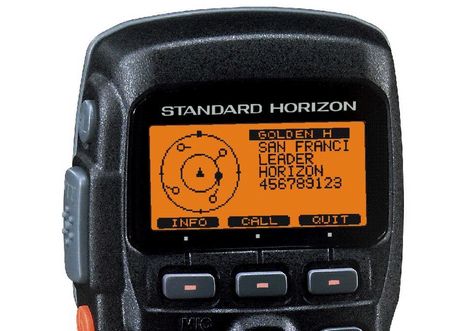

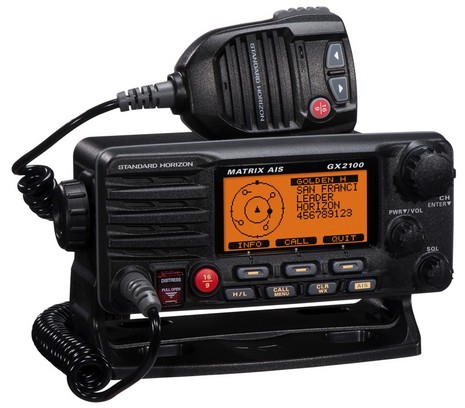











Yeah, I’m still waiting for it (SH GX2100) to be released here in the UK as we are always walking behind the US 🙁
For safety we will be equipping all our crew with hand-held VHF radios with GPS and DSC (e.g., SH HX850/HX851).
Can the GX2100 be configured to continuously track them and report last known position if one of them disappears (goes overboard and stays submerged)? If not, do you know of any other unit that can?
Thanks!
Digging thru the Docket for the Coast Guard’s NPRM expanding AIS requirements, I was glad to note that it’s likely that covered vessels moving above 24 knots will need to have class A AIS installed, and B will remain optional for most others.
John,
those handhelds are DSC capable not AIS.
For a MOB AIS solution, check out the EasyRescue
http://www.easyais.com/en/easyrescue.php
Derek
Thanks, Derek! EasyRescue looks very interesting, and I’d missed it completely.
John, I think you’ll find that the GX2100 can do individual position requests to each handheld well, but that’s about it. Both the latest Lowrance and Garmin fixed VHFs can do purportedly do automated position requests with up to three DSC radios, delivering the positions to an MFD via NMEA 2000. I tried it a bit with a Garmin VHF 200 and an HX850, and they seemed to work together well. But the feature is meant for tracking buddy boats, not crew members. I intend to do much more testing of this stuff.
Derek,
Thanks, but I don’t think AIS is as useful and effective as VHF with DSC+GPS (currently at least) because so few recreational boats have AIS receivers as compared to VHF, and it’s a lot more expensive and hard to get.
What I’m looking for is a boat VHF that will automatically track crew VHF units and record/report the last known position if a crew VHF unit stops responding (ideally with an alarm), as might happen if a crew member went overboard unconscious with the VHF radio submerged.
Fair winds,
John
John, Mobilarm has had a DSC-based MOB system for a while:
https://panbo.com/archives/2008/06/mobilarm_vpirb_interesting_idea_with_the_wrong_acronym.html
cant understand why they didn’t come out with a transponder, given that most of the transmit and receive gubbins is already there. I’ll wait a little longer… (I love SH kit)
I’m not sure we’ll ever see a VHF radio and an AIS transponder combined in one case, Dave. That’s because the rules governing transponder design are pretty darn rigid, which is probably a good thing.
The ICOM MR-500 brochure is up on their US website (look under marine then navigation). It only works with what sounds like new firmware for the VHF 604/504 radios. The only connection to the VHF radios is NMEA 183. Thus my guess is that the new radio’s ability to call AIS stations will work with anybody’s AIS unit. Yes, we might need to watch the NMEA line to see a proprietary ICOM sentence but that should be easy for third-parties to reverse engineer.
No mention on the web site if VHF firmware upgrades will be offered or if they want customers buying a new radio just for the firmware.
Thanks, Craig, excellent points. My understanding is that Icom will be offering firmware updates for existing 604 and 504 radios, but they’ll have to be sent in, cost yet unknown.
I don’t know if the “set up call on xx channel to yy MMSI” command is a standard NMEA 0183 message, nor am I even positive that it’s standard on NMEA 2000. I do know that even when you do get this stuff to work, and place a direct DSC call to an AIS target, there’s no guarantee that they’ll respond. Many VHF radios have to be told to respond to direct DSC calls and switch to the requested channel, and even if they are set up that way, the final connection usually doesn’t happen until a watch stander hits an “accept call” button.
The direct call to AIS targets is a great technology, I think, but it’s bleeding edge, and it will take a while before it works consistently.
Thanks Ben, but I think Mobilarm VPIRB is way too expensive for what it is (and doesn’t address my desire to get a last known position fix report) — I’d rather have a less expensive and more capable SH HX851.
Hi John, where the V100 PLB from Mobilarm is different is that it can be automatically activited in a man overboard event, and keeps transmitting until turned off, which of course a handheld radio wont do. You could program it to transmit to a specfic MMSI number its position on a predetermined time frame, however changing / charging the battery regulary would be the issue, its not been designed for tracking non emergency events.
Hi Lindsay,
A hand-held VHF radio with DSC and GPS (e.g., SH HX851) is turned on the entire time a crew member is on deck, so it will still be on if that crew member goes overboard, and can be interrogated by DSC for its precise location by other DSC radios (boats or hand-helds) even if the crew member is unable to active the DSC distress call.
The caveat of course is that no radio will work unless it is clear of the water, and a hand-held VHF radio is harder to mount so it will be clear of the water if the wearer is unconscious than the V100 PLB.
On the other hand, the V100 PLB is much more limited in that it can’t be used as a conventional VHF radio or DSC (or GPS like the SH HX851), and so expensive that I don’t think our crew would be willing to buy into it, and I don’t know of any place that rents them — do you?
These are reasons why I feel the new SH HX851, which I’ve seen online for under $220, is a much better safety solution than the V100 PLB.
John
John, I’ve pushed the value of DSC for a conscious MOB for some time, even with Standard’s HX470s which doesn’t have a GPS:
https://panbo.com/archives/2007/08/handheld_dsc_vhfgps_i_wish.html
So, while it’s not a true dedicated MOB system, I definitely understand your idea of crew members with HX851s. But it is a fairly bulky device. Do you have a scheme for how they can comfortably carry them? I wonder if one of these SAR/ski patrol chest packs would work on a boat:
http://www.rescueresponse.com/store/Radio_Chest_Harness_Communication.html
Hi Ben,
I like the Radio Chest Harness at http://www.gomed-tech.com/catalog/radio-chest-harness.htm, which can also handle a multi-tool.
Most of us wear an inflatable PFD with integrated safety harness, so the radio harness will have to go under that, interfering with access to the radio.
An alternative to the SH HX805S/HX851 (and roughly the same size) is the Lowrance LHR-80: http://www.lowrance.com/en/Products/Marine/DSC-VHF-Marine-Radios/LHR-80/
John
p.s. My own (new) blog is at http://tips.navas.us
I have a sample of the LHR-80 here, John, and while it’s got a lot going for it, it has been inconsistent in DSC tests so far. I need to test more, and also find out if the firmware has changed.
Your new blog looks great, and I’m happy to point out to Panbo readers that you also wrote the best explanation of VMG I’ve seen:
http://knol.google.com/k/why-vmg-matters#
I would like to know how to test a NMEA DSC call from a VHF to a PC running Nobletec when there is no one around who has a VHF set up to send a polling call. I simply want to see if a calling vessel’s position will appear on my monitor to verify my wiring and connections are correct? At this point, Nobletec can’t find a NMEA sentence to open the com port. Is there some way to generate a NMEA DSC sentence for test purposes?
Hi Mike,
I don’t know of any NMEA generator that includes support for DSC sentences — I would normally recommend Sailsoft tools (free trials available), but I don’t see any references to DSC, although you might want to check to be sure.
I think your best bet might be to borrow (or buy) a DSC-equipped VHF radio to generate real DSC position reports.
John